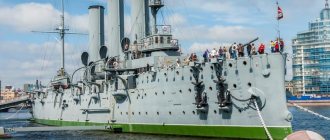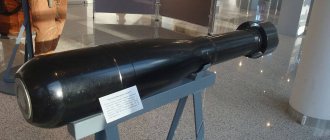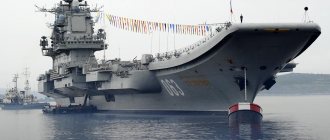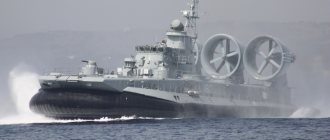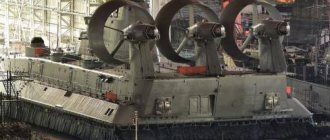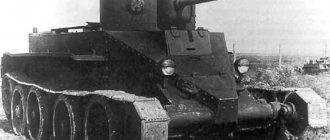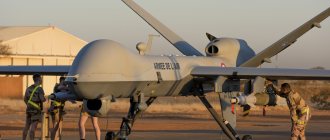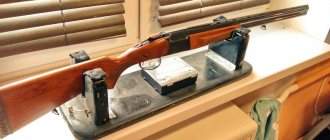The blitzkrieg strategy developed in Germany before World War II did not include the use of heavy breakthrough tanks. Accordingly, there were initially no precise regulations or developments in this direction. This state of affairs remained until the collision with Soviet tanks.
The first battles with the KV and T-34, the disruption of the blitzkrieg strategy and the collision with fortified defenses - all this showed the poor effectiveness of the Panzerkampfwagen III and IV medium tanks that were in service. There was a need to urgently develop more powerful machines.
Tank Panzerkampfwagen VI Ausf. H1 Tiger is a German heavy tank used by Germany during World War II. Designed to combat enemy tanks and anti-tank weapons, as well as to overcome enemy defense lines.
The history of the creation of the Tiger tank
Tank "Tiger-1"
The first developments in the creation of heavy tanks in Germany date back to 1937. Research was given a secondary role, since there was no need for breakthrough machines. In this context, the projects were of a theoretical or test nature.
In 1939-41 Erwin Aders took practical steps to design breakthrough tanks. The first prototypes were assembled using components from the PzKpfw IV. These samples were not positioned as heavy vehicles - their weight should not exceed 30 tons, and the armor thickness was less than 50 mm.
The attack on the USSR showed the weakness of the PzKpfw IV. As they overcame the difficult situation in the first months and strengthened their defenses, Soviet troops resisted tank offensives and German assaults more and more effectively.
Taking these factors into account, a practical need arose for heavy breakthrough tanks capable of competing with the T-34 and KV. An attempt to modernize existing machines did not give the desired result, although it did improve the situation. For Germany, the primary task was to develop an analogue of the Soviet HF.
Tiger 1
The terms of reference for the development of a heavy tank were received immediately by two and Porsche. Both companies presented their designs for Hitler's birthday in April 1942. Preference was given to Henschel's designs.
In his project, Erwin Aders used traditional developments in German tank building, used in the design of the PzKpfw IV. This solution reduced the production complexity of the new tanks. Also for the first time, a staggered arrangement of road wheels was used for tanks.
However, the Henschel Tiger 1 project actually did not have a turret; its prototype was being finalized. In this case, it was planned to use the KwK 42 L/70 gun with a 75 mm caliber, which in 1942 no longer met the assigned tasks. In this context, it was decided to borrow the tower from the Porsche project. It was this hybrid of the two companies that became known as Panzerkampfwagen VI Ausf. H1 Tiger. In the USSR it is known as the Tiger tank, T-6, T-VI.
Tiger 2
“Royal Tiger”
The task to develop a tank with reinforced armor was received by Henschel and Porsche already in August 1942. The emphasis was on the angular arrangement of the plates, similar to the T-34, as well as on the more powerful KwK 43 L/71 caliber gun 88 mm.
The Henschel project turned out to be more successful this time too. The Porsche prototype was rejected mainly due to its complex electric powertrain. The latter required large quantities of copper and other materials, which Germany had in short supply.
The contract for a new tank with Henschel was signed at the beginning of 1943. However, Erwin Aders was offered to finalize the project and introduce a number of design solutions from the parallel development of Panther-II. This aspect delayed the construction of the new tank for several more months. The first prototype was assembled only in October 1943.
The new project became known as Panzerkampfwagen VI Ausf. B, "Royal Tiger", "Tiger II", Tiger 2. Given that Porsche had begun producing turrets for its tanks before its design was rejected, the first 50 "Royal Tigers" received its turrets. Subsequent models were equipped with Aders turrets with a simplified layout and increased frontal armor.
Need and choice
On June 22, 1941, Germany entered the war with the Soviet Union without a serial heavy tank in service (not counting several captured French and British vehicles that did not fight on the Eastern Front). At the same time, the Soviet Union had a large number of heavy KV and medium T-34 tanks, which with their 76.2 mm guns easily hit any German tank, despite the fact that German tanks were practically powerless against the armor of the KV and T-34. The Germans had to use 88-mm heavy anti-aircraft guns and 105-mm field guns. And of course, the ubiquitous Luftwaffe helped... As you can see, the superiority of Soviet tanks was offset by the tactical superiority of the Germans. But this is a completely different topic.
These tanks were loaded onto platforms with a second row of wheels and wide tracks installed. Transport narrow tracks lie near the tank. This is a rare case of such transportation; it is likely that tanks will be delivered directly to the combat area
At the end of 1941, Henschel concentrated its efforts on developing the H1 prototype. The project was completed on April 17, 1942. On April 19, 1942, both prototypes (P - Porsche and H - Henschel) arrived at the railway station near Rastenburg and then went under their own power to Rastenburg. It was only 11 km to the city, but both cars managed to break down several times during the trip. The prototypes were shown to Adolf Hitler on his birthday, April 20, 1942. The next day both cars arrived at the headquarters. After the ceremonial part (Ferdinand Porsche was awarded the “Cross of Military Merit, 1st Class”), Hitler examined Porsche’s car for about half an hour, listening carefully to the designers’ explanations. He spent only 2-3 minutes on the Henschel tank. After lunch Goering arrived. In the presence of him and Armaments Minister Speer, speed tests took place. On a section of 1000 m, VK 4501 (P) reached a maximum speed of 50 km/h, and its competitor on a section of 850 m reached 45 km/h. In this case, the VK 4501(N) engine overheated so much that there was a risk of fire. After the engine cooled down, the tank was ready for action again. Chief engineer Kurt Arnold offered Speer comparative maneuverability tests, apparently not without a secret intent: he knew well the weak points of the Porsche car. The crude, unfinished electric transmission seriously hampered maneuvering. The VK 4501(P) tank, for example, had great difficulty making turns at 900. Against this background, the VK 4501(N) showed its best side - the multi-ton vehicle literally spun on its heels, delighting the audience. However, this demonstration of tanks, in fact, did not solve anything - real tests lay ahead at the Berka training ground, where two VK 4501 (P) and one VK 4501 (N) arrived in May 1942. As a result, the Porsche tank, as in the case of the VK 3001 (P), was found to have low reliability of the electric transmission. In addition, the car had unsatisfactory cross-country ability and a small power reserve - only 50 km. Since Hitler wanted to use new tanks in North Africa, this figure had to be at least 150 km. It turned out to be impossible to place additional fuel in the tank due to lack of space. It was easy to foresee the numerous difficulties that could arise when operating a combat vehicle at the front. The unusual transmission required retraining of driver mechanics and repair service specialists. After weighing all the pros and cons, despite Hitler’s special affection for Dr. Porsche, the commission conducting the tests decided in favor of the tank. Hitler was forced to agree. The vehicle received the designation Pz.Kpfw.VI (Sd. Kfz.181) Tiger Ausf.H1, and after the Tiger II tank was put into service in 1944, the name was changed to Tiger Ausf.E or Tiger I.
The VK 4501 (P) chassis, already manufactured at the Nibelungenwerke 90 plant, was decided to be used as a base for heavy assault guns armed with an 88-mm anti-tank gun, created on the basis of the Flak 41 anti-aircraft gun with a barrel length of 71 calibers - the future “Ferdinands”. But more on this later.
Structure and design of the combat unit
The Tiger
tank The design of the Tiger tank was distinguished by good ergonomics, ensuring reliability and ease of control and combat.
Front compartment
The control department was intended for the driver and gunner-radio operator. The controls include a steering wheel made like a car, gas pedals, clutch and brake pedals. To the right in front of the seat there is a gear lever and a parking brake. There was another one of the same kind on the left. There are emergency control levers behind the seat.
There was a front-facing machine gun in the front of the hull. External communication devices were also located here. The FuG-5 radio units were located next to the radio operator’s seat. A stable connection for transmitting and receiving information worked within a range of 6.4 km for telephone and 9.4 km for telegraph.
For internal communication, laryngophones and headphones connected to a tank intercom were used. The vulnerability of this system was supplemented by experimental light signals, allowing the commander to give simple commands to the driver.
Middle part of the car
The fighting compartment included the rest of the crew, observation and guidance devices, and ammunition. The positions of the commander, gunner and loader were located here. There was also a machine gun coaxial with the gun.
To the left of the gun was an optical sight. At first it was a Zeiss binocular TZF-9a with 2.5x magnification. Since April 1944, monocular TZF-9b with a magnification range of 2.5-5 times have been used. The aiming scale for the gun varied in the range of 100-4000 m, for the machine gun - from zero to 1200 m.
Aft
At the rear of the tank there was an engine compartment and fuel tanks. To protect the crew in the event of an explosion, there was an armored partition between the stern and the fighting compartment.
Hull and turret
The installation of an 88 mm caliber gun determined the design features of the Tiger's hull. For the first time, the width of a German tank had different meanings. The lower part became the base part, the upper part was expanded with sponsons to install the required turret ring for the prescribed gun.
Almost all the armor plates of the hull are joined at an angle close to a straight line. The frontal armor is sloped at 80 degrees and houses a machine gun and a driver's observation device. The top sheet is located almost horizontally, the bottom - at an angle of 66 degrees. All sheets are connected using dovetail joints.
The tank's turret is located almost in the center with a slight offset to the stern. The roof has two hatches and a ventilation hole, closed by an armored cap with horizontal slits. Later models featured a periscope for the loader, as well as a mortar for firing smoke and fragmentation grenades at short distances.
How to play Tiger 1
It is immediately worth noting the pride of the legendary German - his 88 mm gun, which is capable of inflicting 240 damage. one-time damage. The damage is not the greatest, but a high reload speed indicates a high DPM. Armor penetration with a basic 203 mm shell is quite enough to withstand the 7th and 8th levels, but against the 9th level you will sometimes have to load premium shells. The accuracy of the gun is quite good; the long aiming time is compensated by the small dispersion. The stabilization of the gun in motion is a record for level 7, which makes the German gun the most comfortable at the level. The tank is armored only in the turret, which means the tall hull will always have to be hidden. It is best, of course, to take positions on terrain, but in open areas, as a rule, enemy artillery is operating, so the margin of safety will be constantly under threat. In the city, Tiger 1 will be protected from artillery shells, but there you will need to use all the features of the gun and outplay your opponent with a fast-firing and accurate weapon. Optimal turnarounds will increase the chances of a rebound or missed penetration, but you shouldn't rely on it. It is best to find mounds or piles of debris that will cover the hull. At the top, you can play in an attacking style and pass through enemy positions, but at the bottom of the list, it is better to stick to the rear of your armored allies and use your rate of fire and accuracy, for example, to blast the enemy when he is on reload, thereby helping your allies.
Vertical aiming angles of -7 degrees will allow you to play from the tower behind low hills. It is worth noting the German’s huge safety margin of 1500 units. Most Tier 8 heavy tanks have these characteristics. Tiger 1 will allow in some cases to exchange shells, having the privilege in the DPM. Armor penetration will be enough for all levels, but heavily armored heavy tanks will have to be penetrated with premium shells.
The German's viewing radius of 380 m will allow him to highlight many enemies on the map, and if you improve it with the help of the "radio interception" and "eagle eye" skills, as well as install the "coated optics" equipment, the heavy German tank will become a record holder at level 7 and quite will be able to replace a light tank, conducting effective reconnaissance.
The disadvantages of the German include its dynamics. The maximum speed of 40 km/h is a good indicator for a heavy class of equipment, but with a specific power of 12 hp/t, the German will pick up speed slowly. Moreover, there will be difficulties at higher elevations. This can be improved with the help of the “off-road king” driver skill. With such dynamics, it is necessary to anticipate in advance the largest concentration of enemy heavy equipment on the map and immediately take the most convenient positions. If the enemy has artillery, then it is recommended to hide behind buildings, playing with sides and turns.
In general, Tiger 1 has a comfortable weapon that will deal damage to almost all enemies, and with a high rate of fire in single combats, the German will always have the upper hand. Accuracy will allow you to target the most vulnerable spots, and the stabilization of the gun will provide comfortable positional firefights. The dynamics of the Tiger are not the best, but it is still a heavy armored tank, so its place will be on the flanks, where it is necessary to restrain enemy attacks and block passages to the base. The safety margin will allow you to live on the battlefield for a long time and exchange damage.
Specifications
Image of the internal layout
of the Tiger tank, the technical characteristics are considered based on the first models. The Royal Tiger, despite its increased power and armor, turned out to be an unsuccessful development due to low engine power, too much weight and poor driving characteristics. Many crews noted the general unreliability of this development and frequent breakdowns.
Suspension and engine
The Tiger engine is a twelve-cylinder, carburetor, gasoline engine from Maybach. The first 250 tanks had HL210 engines with a power of 650 hp. With. Subsequent ones - HL230 with 700 hp. With. The suspension is independent, torsion bar.
The engine compartment had its own fire extinguishing system. Fire extinguishers were located next to the fuel pumps and carburetor. A water radiator and four fans were used to cool the engine.
Chassis and tracks
The chassis of the tank is based on a staggered arrangement of rollers. The diameter is large, there are no support rollers. The drive wheel was located in front, the diameter was 0.84 m. A rubber band was provided for the road wheels.
The Tigers used two types of tracks. The first option was used for transportation, width - 0.52 m, tracks K.gs-63/520/l30. The second version of the combat tracks, made from Kgs-63/725/130 tracks, width - 0.725 m.
Transmission
The twelve-speed gearbox (8 front and 4 rear) interacted with the main clutch and the turning mechanism. It is of the preselective type, with semi-automatic control. Thanks to the gearbox, the tank had 16 turning radii forward and 8 backward, and could also rotate around its axis.
Fuel consumption
Leaded gasoline OZ 74 was used as fuel. Fuel tanks are designed for 530 liters. Average fuel consumption was 80-100 liters per 100 km.
Maximum speed
The highest speed of the Tiger tank on the highway was 44 km/h, and the range was 195 km. The vehicle had good maneuverability and could climb inclines up to 35 degrees. The height of the barrier to be overcome is 0.8 m, the width of the ditch is 2.3 m, the ford is 1.2 m.
Crew
The Tiger's crew consisted of five people - a driver, a gunner-radio operator, a commander, a gunner and a loader. The first two were located in the control compartment, ensuring the movement of the tank and communication with other vehicles. The rest were in the fighting compartment.
Dimensions and weight
In terms of dimensions, the Tiger had the following technical characteristics:
- hull length - 6.316 m, with the gun turned forward - 8.45 m;
- width - 3.705 m;
- height - 2.93 m;
- ground clearance - 0.47 m.
The question of how much the tank weighs is easily resolved - the combat weight was 57 tons. With this weight, the specific pressure on the ground was 1.03 kilograms per square centimeter.
Crew skills
Before upgrading the crew's perks, you need to study the strengths and weaknesses of the tank. Recommended skills that need to be upgraded step by step for the crew:
| commander |
| gunner |
| driver mechanic |
| radio operator |
| charging |
Since this is a heavy tank, it first needs to upgrade its firepower. “Smooth motion” and “smooth turret rotation” will improve the stabilization of the gun in motion. “Radio Interception” and “Eagle Eye” will increase the maximum viewing radius. “The Combat Brotherhood will improve crew performance by 5%, including reloading and visibility. The “sniper” skill will increase the chances of damaging modules, which will be useful in martial arts, and by upgrading the “king of off-road” perk, the German will become more confident in moving on sticky soils.
The rest of the skills can be learned at your own discretion.
Armament
A preserved copy at the exhibition.
The Tiger's armament consisted of a cannon and two machine guns - a front-mounted machine gun and a turret-mounted one, coaxial with the gun. Later, mortars appeared that made it possible to create a smoke screen or hit nearby infantry with fragmentation grenades.
A gun
The main weapon of the tank is a KwK 36 L/56 rifled gun with a caliber of 88 mm. The barrel length was 56 calibers. Thanks to the hydraulic drive, the gun could fire in a complete circle in the horizontal plane. The vertical guidance range varied from -8 to +15 degrees.
The destruction range was 4 km, with the advent of the new TZF 9b monocular sight - 5 km. The ammunition consisted of 92-94 shells. Since 1945, this figure has been increased to 120 ammunition.
Machine guns
The Tigers had two, less often three, MG-34 machine guns. On later models, its modifications were used - 34/40, 34/S, 34-41. Firing from the front machine gun was carried out by the radio operator, and from the coaxial machine gun by the gunner. The destruction range is up to 1200 m, the total ammunition load is 4500 rounds.
Smoke grenade launchers
S-type anti-personnel mortars were used as grenade launchers. in addition to creating smoke screens, they fired fragmentation grenades to a height of 5-7 meters. The explosion at such a height hit the infantry surrounding the tank.
Equipment
It is recommended to install the following equipment on the German:
A medium caliber rammer will speed up the already fast reload time. The vertical stabilizer will allow you to hit more often while moving, and improved ventilation will improve the performance of the entire crew by 5%.
This combination indicates a significant improvement in firepower.
As an alternative, you can install the following modules:
By replacing improved ventilation with coated optics, the player will improve the tank's viewing radius, which is already considered its advantage. You can replace the vertical stabilizer with improved ventilation. The tank will shoot worse while moving, but all the characteristics of the crew will improve slightly.
Armor protection
To protect the tank, chrome-molybdenum rolled armor with surface hardening was used. Its thickness had the following indicators:
- upper front plate of the hull - 100 mm, 8 degrees of inclination;
- average frontal - 63 mm, 10 degrees;
- lower frontal - from 100 mm at 21 degrees of inclination with a transition to 80 mm at a bevel of 66 degrees;
- hull sides - 80 and 63 mm at the top and bottom at zero inclination;
- rear part - 80 mm with an inclination of 8 degrees at the top and 48 at the bottom.
The bottom of the hull had a thickness of 28 mm, the roof was initially 26 mm, in 1944 both indicators increased to 40. The frontal armor of the turret was 100 mm, the sides and rear were 80, and the slopes were zero. The gun mantlet varied from 90 to 200 mm.
Advantages and disadvantages of the Tiger
Among the advantages of the Tigers are:
- a powerful weapon that made it possible to hit almost all self-propelled guns and tanks head-on until 1944;
- armor that provided reliable protection for the tank until 1943;
- good ergonomics, ensuring ease of control from the inside;
- high-quality surveillance and communication devices.
In most cases, it was the latter factor that turned out to be decisive for the outcome of the battle. According to some estimates, the Tiger's advantages made it the strongest tank in the world in 1942-43.
However, the car also had disadvantages:
- technical complexity of production, which slowed down mass production;
- high cost - Tigers cost twice as much as many tanks from other countries;
- low maintainability of the chassis and some other units due to a lack of parts;
- difficulty of transportation, especially across bridges.
These factors greatly complicated the use of the Tigers. Towing damaged vehicles for repairs required special equipment, which was not always convenient in a front-line situation. And rail transportation of such tanks required one empty car at the front and rear to lighten the load.
Use of the Tiger tank in World War II
"Tiger" with its crew
The concept of using "Tiger" tanks allowed for their use in both offensive and defensive situations. The main task is to fight tanks, ensuring the breakthrough of one’s forces through fortification lines or reducing the enemy’s ability to break through.
The first use in battle dates back to August 23, 1942 near Leningrad. Immediately after unloading, problems appeared with the gearbox and engine, as a result of which the tanks were sent for repairs. In September, the situation repeated itself; due to impassability and technical problems, the Tigers were unable to realize their potential.
Full participation in hostilities dates back to the battles near Kharkov in February-March 1943. Later, the Tigers took part in the Battle of Kursk, on the African and Italian fronts. In 1944-45, tanks were actively used on the eastern and western fronts.
Soviet troops were able to capture the first serviceable Tiger on December 27, 1943 near Leningrad. Along with the vehicle, technical documentation, instruments, and weapons were also seized. On January 5-7, the tank was used by Soviet troops to defend captured positions.
During the war, captured tanks were captured by other units in different sectors of the front. However, such vehicles did not find active use - the lack of spare parts, the complexity of repairs and towing did not allow the damaged vehicles to be returned to service.
